Management and Operations in Toyota: Leadership and Analysis
VerifiedAdded on 2020/10/23
|19
|6426
|56
Report
AI Summary
This report provides a comprehensive analysis of Toyota's management and operations. It begins with an introduction to Toyota, its management structure, and the definitions and differences between managers and leaders. The report then delves into the functions and characteristics of managers and leaders, supported by various theories and concepts, including Classical Management theory, Human Relations theory, and System Theory. The analysis extends to different leadership approaches, such as Situational leadership theory and System leadership theory, along with their strengths and weaknesses. The second part of the report focuses on Toyota's key operational functions, roles, and responsibilities of managers, and operational approaches. It evaluates the impact of external business environment factors on Toyota and explores approaches to leadership and management to improve operational efficiencies. The report concludes with recommendations for future improvements, offering valuable insights into Toyota's operational strategies and leadership practices.

Management And
Operations
Operations
Paraphrase This Document
Need a fresh take? Get an instant paraphrase of this document with our AI Paraphraser
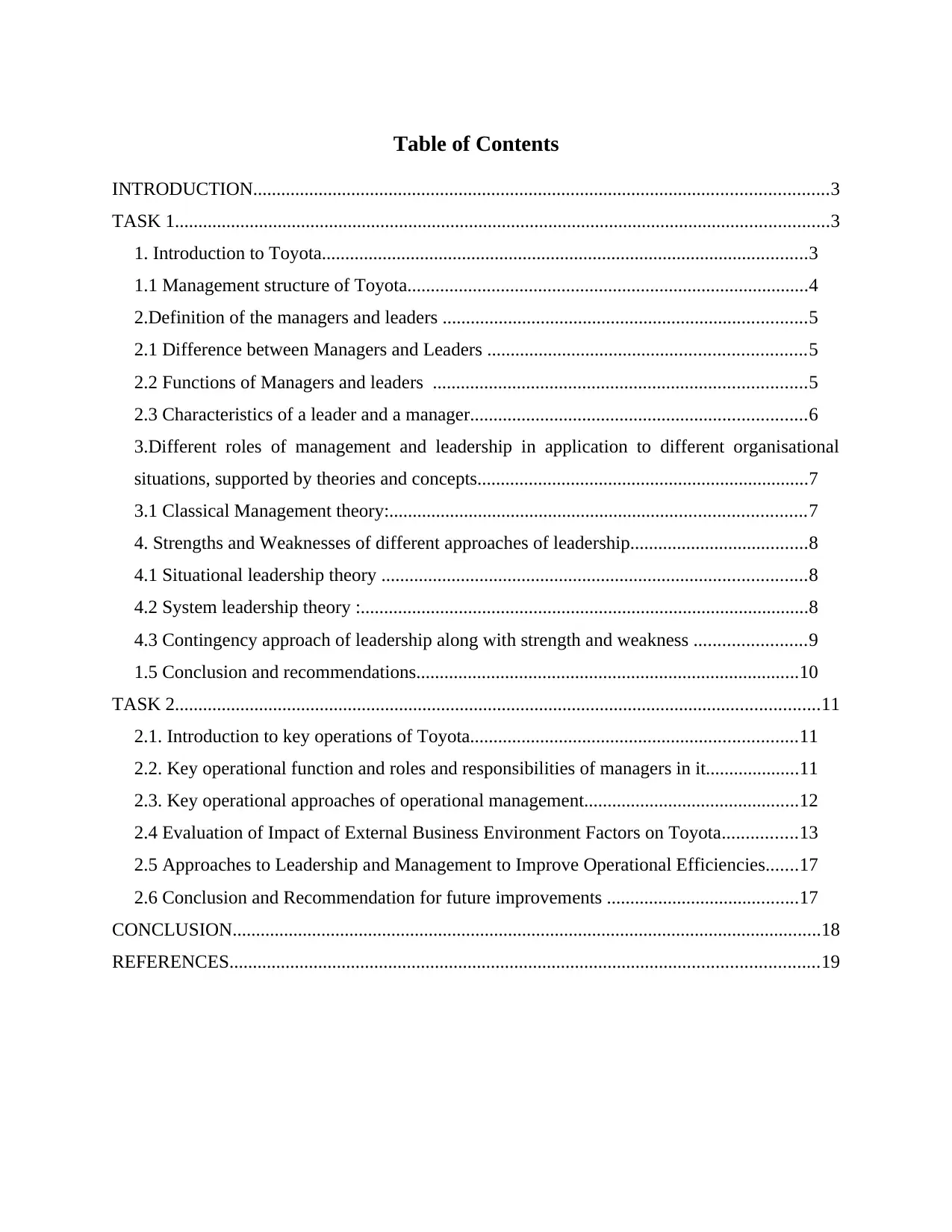
Table of Contents
INTRODUCTION...........................................................................................................................3
TASK 1............................................................................................................................................3
1. Introduction to Toyota........................................................................................................3
1.1 Management structure of Toyota......................................................................................4
2.Definition of the managers and leaders ..............................................................................5
2.1 Difference between Managers and Leaders ....................................................................5
2.2 Functions of Managers and leaders ................................................................................5
2.3 Characteristics of a leader and a manager........................................................................6
3.Different roles of management and leadership in application to different organisational
situations, supported by theories and concepts.......................................................................7
3.1 Classical Management theory:.........................................................................................7
4. Strengths and Weaknesses of different approaches of leadership......................................8
4.1 Situational leadership theory ...........................................................................................8
4.2 System leadership theory :................................................................................................8
4.3 Contingency approach of leadership along with strength and weakness ........................9
1.5 Conclusion and recommendations..................................................................................10
TASK 2..........................................................................................................................................11
2.1. Introduction to key operations of Toyota......................................................................11
2.2. Key operational function and roles and responsibilities of managers in it....................11
2.3. Key operational approaches of operational management..............................................12
2.4 Evaluation of Impact of External Business Environment Factors on Toyota................13
2.5 Approaches to Leadership and Management to Improve Operational Efficiencies.......17
2.6 Conclusion and Recommendation for future improvements .........................................17
CONCLUSION..............................................................................................................................18
REFERENCES..............................................................................................................................19
INTRODUCTION...........................................................................................................................3
TASK 1............................................................................................................................................3
1. Introduction to Toyota........................................................................................................3
1.1 Management structure of Toyota......................................................................................4
2.Definition of the managers and leaders ..............................................................................5
2.1 Difference between Managers and Leaders ....................................................................5
2.2 Functions of Managers and leaders ................................................................................5
2.3 Characteristics of a leader and a manager........................................................................6
3.Different roles of management and leadership in application to different organisational
situations, supported by theories and concepts.......................................................................7
3.1 Classical Management theory:.........................................................................................7
4. Strengths and Weaknesses of different approaches of leadership......................................8
4.1 Situational leadership theory ...........................................................................................8
4.2 System leadership theory :................................................................................................8
4.3 Contingency approach of leadership along with strength and weakness ........................9
1.5 Conclusion and recommendations..................................................................................10
TASK 2..........................................................................................................................................11
2.1. Introduction to key operations of Toyota......................................................................11
2.2. Key operational function and roles and responsibilities of managers in it....................11
2.3. Key operational approaches of operational management..............................................12
2.4 Evaluation of Impact of External Business Environment Factors on Toyota................13
2.5 Approaches to Leadership and Management to Improve Operational Efficiencies.......17
2.6 Conclusion and Recommendation for future improvements .........................................17
CONCLUSION..............................................................................................................................18
REFERENCES..............................................................................................................................19
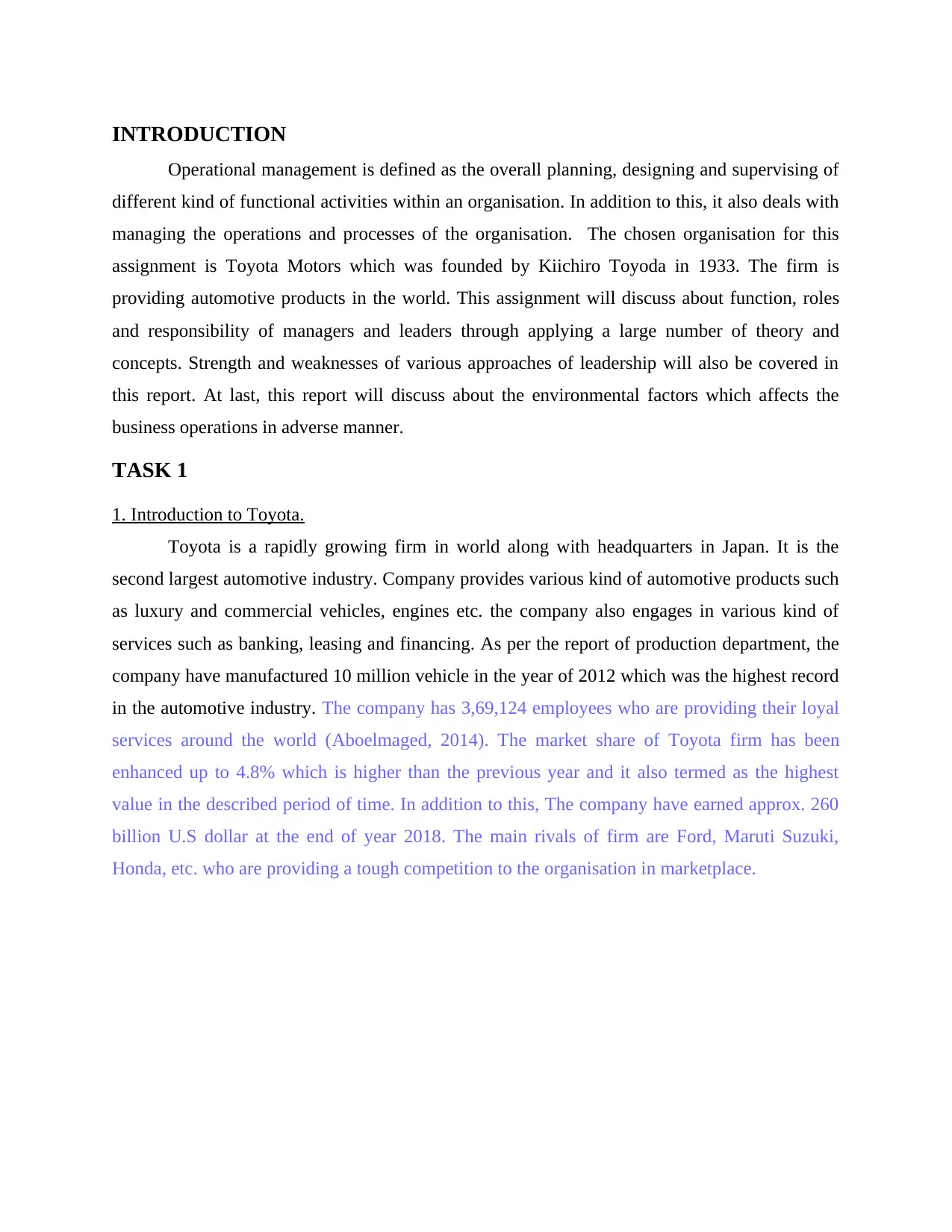
INTRODUCTION
Operational management is defined as the overall planning, designing and supervising of
different kind of functional activities within an organisation. In addition to this, it also deals with
managing the operations and processes of the organisation. The chosen organisation for this
assignment is Toyota Motors which was founded by Kiichiro Toyoda in 1933. The firm is
providing automotive products in the world. This assignment will discuss about function, roles
and responsibility of managers and leaders through applying a large number of theory and
concepts. Strength and weaknesses of various approaches of leadership will also be covered in
this report. At last, this report will discuss about the environmental factors which affects the
business operations in adverse manner.
TASK 1
1. Introduction to Toyota.
Toyota is a rapidly growing firm in world along with headquarters in Japan. It is the
second largest automotive industry. Company provides various kind of automotive products such
as luxury and commercial vehicles, engines etc. the company also engages in various kind of
services such as banking, leasing and financing. As per the report of production department, the
company have manufactured 10 million vehicle in the year of 2012 which was the highest record
in the automotive industry. The company has 3,69,124 employees who are providing their loyal
services around the world (Aboelmaged, 2014). The market share of Toyota firm has been
enhanced up to 4.8% which is higher than the previous year and it also termed as the highest
value in the described period of time. In addition to this, The company have earned approx. 260
billion U.S dollar at the end of year 2018. The main rivals of firm are Ford, Maruti Suzuki,
Honda, etc. who are providing a tough competition to the organisation in marketplace.
Operational management is defined as the overall planning, designing and supervising of
different kind of functional activities within an organisation. In addition to this, it also deals with
managing the operations and processes of the organisation. The chosen organisation for this
assignment is Toyota Motors which was founded by Kiichiro Toyoda in 1933. The firm is
providing automotive products in the world. This assignment will discuss about function, roles
and responsibility of managers and leaders through applying a large number of theory and
concepts. Strength and weaknesses of various approaches of leadership will also be covered in
this report. At last, this report will discuss about the environmental factors which affects the
business operations in adverse manner.
TASK 1
1. Introduction to Toyota.
Toyota is a rapidly growing firm in world along with headquarters in Japan. It is the
second largest automotive industry. Company provides various kind of automotive products such
as luxury and commercial vehicles, engines etc. the company also engages in various kind of
services such as banking, leasing and financing. As per the report of production department, the
company have manufactured 10 million vehicle in the year of 2012 which was the highest record
in the automotive industry. The company has 3,69,124 employees who are providing their loyal
services around the world (Aboelmaged, 2014). The market share of Toyota firm has been
enhanced up to 4.8% which is higher than the previous year and it also termed as the highest
value in the described period of time. In addition to this, The company have earned approx. 260
billion U.S dollar at the end of year 2018. The main rivals of firm are Ford, Maruti Suzuki,
Honda, etc. who are providing a tough competition to the organisation in marketplace.
⊘ This is a preview!⊘
Do you want full access?
Subscribe today to unlock all pages.

Trusted by 1+ million students worldwide
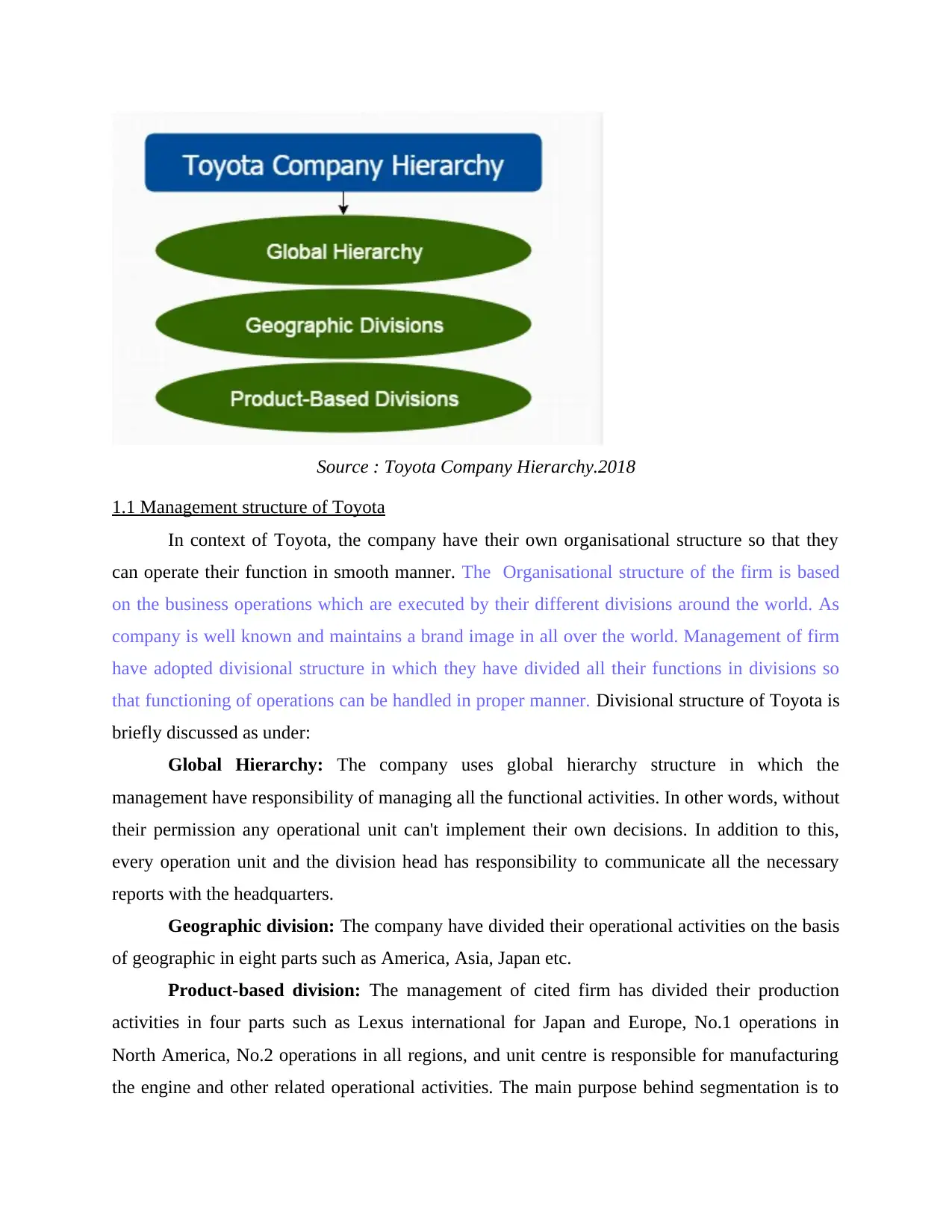
Source : Toyota Company Hierarchy.2018
1.1 Management structure of Toyota
In context of Toyota, the company have their own organisational structure so that they
can operate their function in smooth manner. The Organisational structure of the firm is based
on the business operations which are executed by their different divisions around the world. As
company is well known and maintains a brand image in all over the world. Management of firm
have adopted divisional structure in which they have divided all their functions in divisions so
that functioning of operations can be handled in proper manner. Divisional structure of Toyota is
briefly discussed as under:
Global Hierarchy: The company uses global hierarchy structure in which the
management have responsibility of managing all the functional activities. In other words, without
their permission any operational unit can't implement their own decisions. In addition to this,
every operation unit and the division head has responsibility to communicate all the necessary
reports with the headquarters.
Geographic division: The company have divided their operational activities on the basis
of geographic in eight parts such as America, Asia, Japan etc.
Product-based division: The management of cited firm has divided their production
activities in four parts such as Lexus international for Japan and Europe, No.1 operations in
North America, No.2 operations in all regions, and unit centre is responsible for manufacturing
the engine and other related operational activities. The main purpose behind segmentation is to
1.1 Management structure of Toyota
In context of Toyota, the company have their own organisational structure so that they
can operate their function in smooth manner. The Organisational structure of the firm is based
on the business operations which are executed by their different divisions around the world. As
company is well known and maintains a brand image in all over the world. Management of firm
have adopted divisional structure in which they have divided all their functions in divisions so
that functioning of operations can be handled in proper manner. Divisional structure of Toyota is
briefly discussed as under:
Global Hierarchy: The company uses global hierarchy structure in which the
management have responsibility of managing all the functional activities. In other words, without
their permission any operational unit can't implement their own decisions. In addition to this,
every operation unit and the division head has responsibility to communicate all the necessary
reports with the headquarters.
Geographic division: The company have divided their operational activities on the basis
of geographic in eight parts such as America, Asia, Japan etc.
Product-based division: The management of cited firm has divided their production
activities in four parts such as Lexus international for Japan and Europe, No.1 operations in
North America, No.2 operations in all regions, and unit centre is responsible for manufacturing
the engine and other related operational activities. The main purpose behind segmentation is to
Paraphrase This Document
Need a fresh take? Get an instant paraphrase of this document with our AI Paraphraser
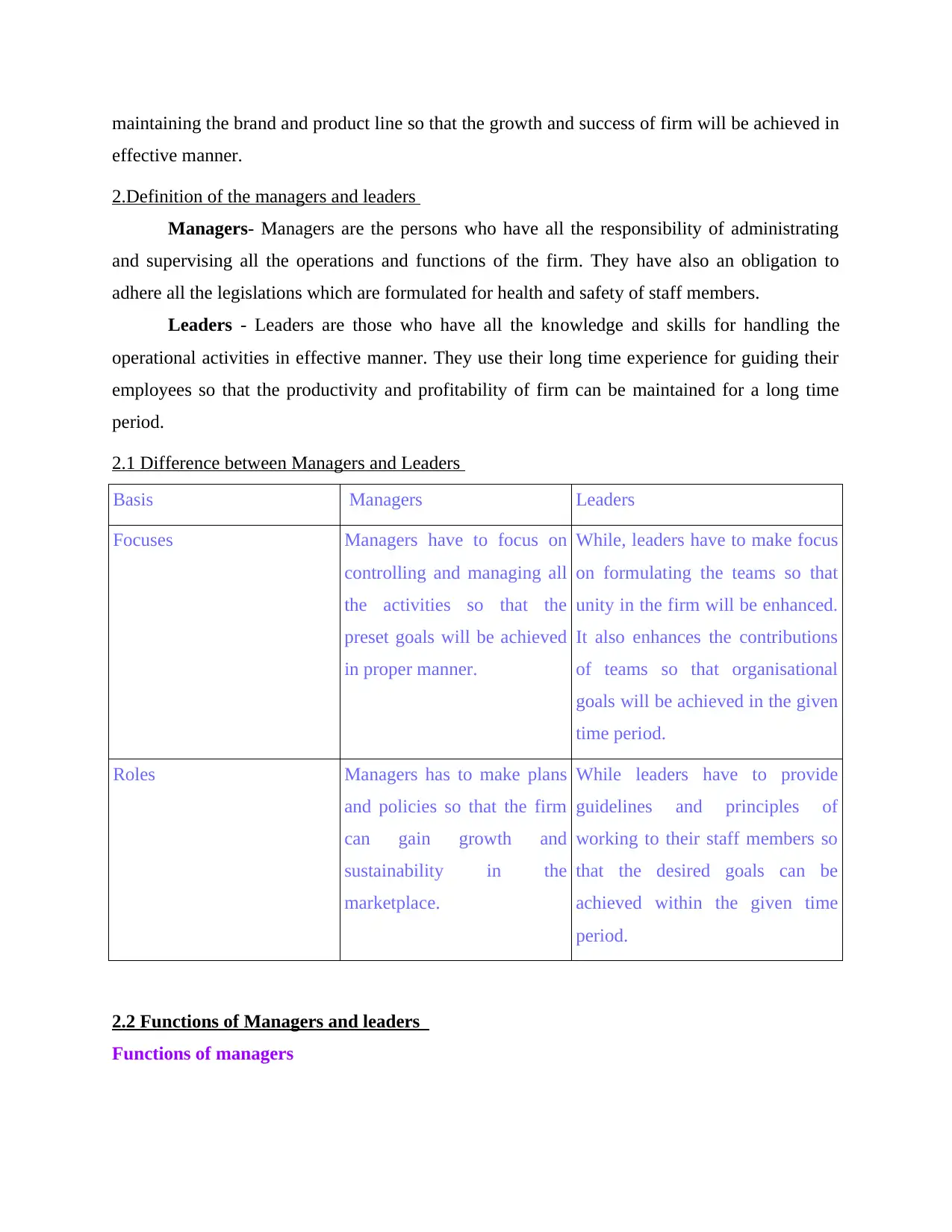
maintaining the brand and product line so that the growth and success of firm will be achieved in
effective manner.
2.Definition of the managers and leaders
Managers- Managers are the persons who have all the responsibility of administrating
and supervising all the operations and functions of the firm. They have also an obligation to
adhere all the legislations which are formulated for health and safety of staff members.
Leaders - Leaders are those who have all the knowledge and skills for handling the
operational activities in effective manner. They use their long time experience for guiding their
employees so that the productivity and profitability of firm can be maintained for a long time
period.
2.1 Difference between Managers and Leaders
Basis Managers Leaders
Focuses Managers have to focus on
controlling and managing all
the activities so that the
preset goals will be achieved
in proper manner.
While, leaders have to make focus
on formulating the teams so that
unity in the firm will be enhanced.
It also enhances the contributions
of teams so that organisational
goals will be achieved in the given
time period.
Roles Managers has to make plans
and policies so that the firm
can gain growth and
sustainability in the
marketplace.
While leaders have to provide
guidelines and principles of
working to their staff members so
that the desired goals can be
achieved within the given time
period.
2.2 Functions of Managers and leaders
Functions of managers
effective manner.
2.Definition of the managers and leaders
Managers- Managers are the persons who have all the responsibility of administrating
and supervising all the operations and functions of the firm. They have also an obligation to
adhere all the legislations which are formulated for health and safety of staff members.
Leaders - Leaders are those who have all the knowledge and skills for handling the
operational activities in effective manner. They use their long time experience for guiding their
employees so that the productivity and profitability of firm can be maintained for a long time
period.
2.1 Difference between Managers and Leaders
Basis Managers Leaders
Focuses Managers have to focus on
controlling and managing all
the activities so that the
preset goals will be achieved
in proper manner.
While, leaders have to make focus
on formulating the teams so that
unity in the firm will be enhanced.
It also enhances the contributions
of teams so that organisational
goals will be achieved in the given
time period.
Roles Managers has to make plans
and policies so that the firm
can gain growth and
sustainability in the
marketplace.
While leaders have to provide
guidelines and principles of
working to their staff members so
that the desired goals can be
achieved within the given time
period.
2.2 Functions of Managers and leaders
Functions of managers
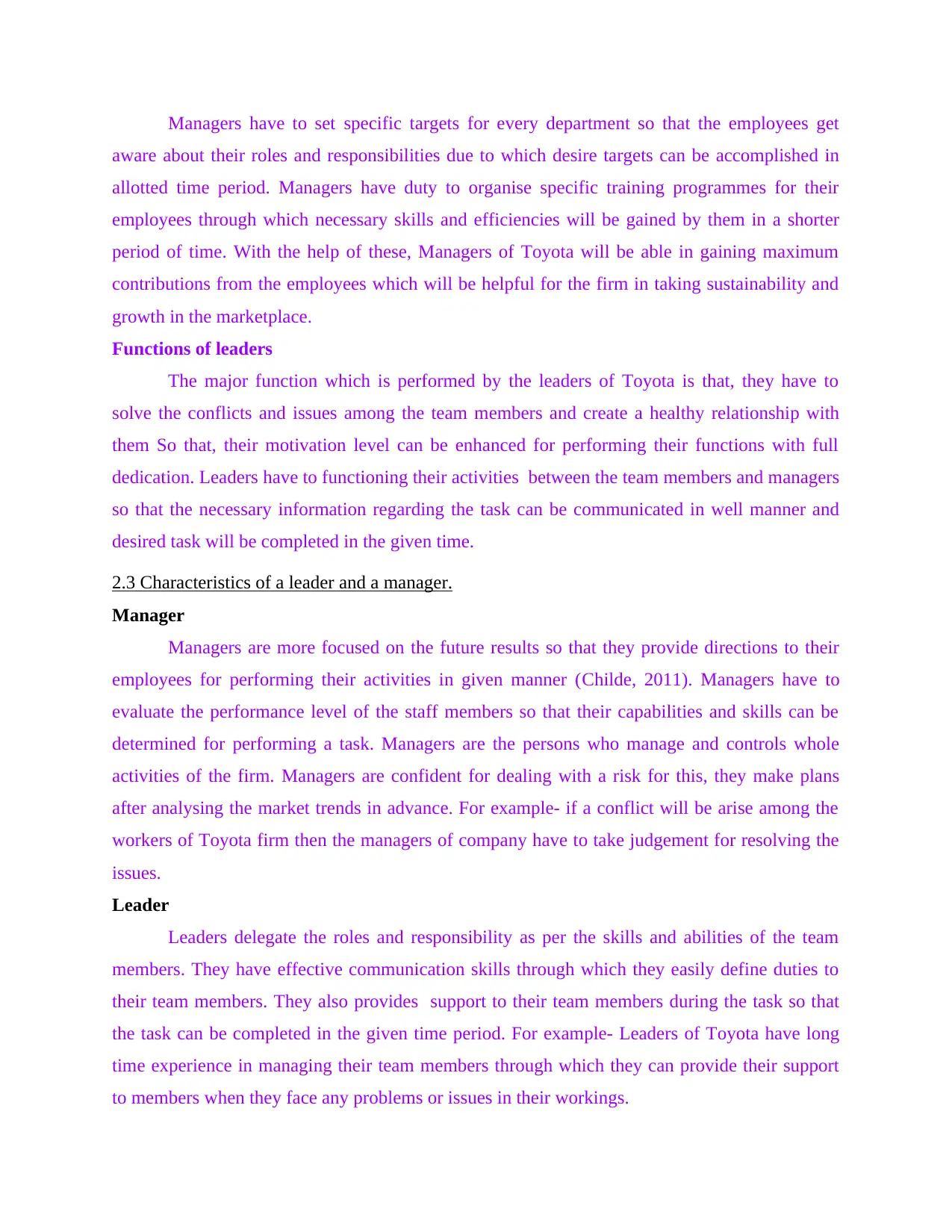
Managers have to set specific targets for every department so that the employees get
aware about their roles and responsibilities due to which desire targets can be accomplished in
allotted time period. Managers have duty to organise specific training programmes for their
employees through which necessary skills and efficiencies will be gained by them in a shorter
period of time. With the help of these, Managers of Toyota will be able in gaining maximum
contributions from the employees which will be helpful for the firm in taking sustainability and
growth in the marketplace.
Functions of leaders
The major function which is performed by the leaders of Toyota is that, they have to
solve the conflicts and issues among the team members and create a healthy relationship with
them So that, their motivation level can be enhanced for performing their functions with full
dedication. Leaders have to functioning their activities between the team members and managers
so that the necessary information regarding the task can be communicated in well manner and
desired task will be completed in the given time.
2.3 Characteristics of a leader and a manager.
Manager
Managers are more focused on the future results so that they provide directions to their
employees for performing their activities in given manner (Childe, 2011). Managers have to
evaluate the performance level of the staff members so that their capabilities and skills can be
determined for performing a task. Managers are the persons who manage and controls whole
activities of the firm. Managers are confident for dealing with a risk for this, they make plans
after analysing the market trends in advance. For example- if a conflict will be arise among the
workers of Toyota firm then the managers of company have to take judgement for resolving the
issues.
Leader
Leaders delegate the roles and responsibility as per the skills and abilities of the team
members. They have effective communication skills through which they easily define duties to
their team members. They also provides support to their team members during the task so that
the task can be completed in the given time period. For example- Leaders of Toyota have long
time experience in managing their team members through which they can provide their support
to members when they face any problems or issues in their workings.
aware about their roles and responsibilities due to which desire targets can be accomplished in
allotted time period. Managers have duty to organise specific training programmes for their
employees through which necessary skills and efficiencies will be gained by them in a shorter
period of time. With the help of these, Managers of Toyota will be able in gaining maximum
contributions from the employees which will be helpful for the firm in taking sustainability and
growth in the marketplace.
Functions of leaders
The major function which is performed by the leaders of Toyota is that, they have to
solve the conflicts and issues among the team members and create a healthy relationship with
them So that, their motivation level can be enhanced for performing their functions with full
dedication. Leaders have to functioning their activities between the team members and managers
so that the necessary information regarding the task can be communicated in well manner and
desired task will be completed in the given time.
2.3 Characteristics of a leader and a manager.
Manager
Managers are more focused on the future results so that they provide directions to their
employees for performing their activities in given manner (Childe, 2011). Managers have to
evaluate the performance level of the staff members so that their capabilities and skills can be
determined for performing a task. Managers are the persons who manage and controls whole
activities of the firm. Managers are confident for dealing with a risk for this, they make plans
after analysing the market trends in advance. For example- if a conflict will be arise among the
workers of Toyota firm then the managers of company have to take judgement for resolving the
issues.
Leader
Leaders delegate the roles and responsibility as per the skills and abilities of the team
members. They have effective communication skills through which they easily define duties to
their team members. They also provides support to their team members during the task so that
the task can be completed in the given time period. For example- Leaders of Toyota have long
time experience in managing their team members through which they can provide their support
to members when they face any problems or issues in their workings.
⊘ This is a preview!⊘
Do you want full access?
Subscribe today to unlock all pages.

Trusted by 1+ million students worldwide
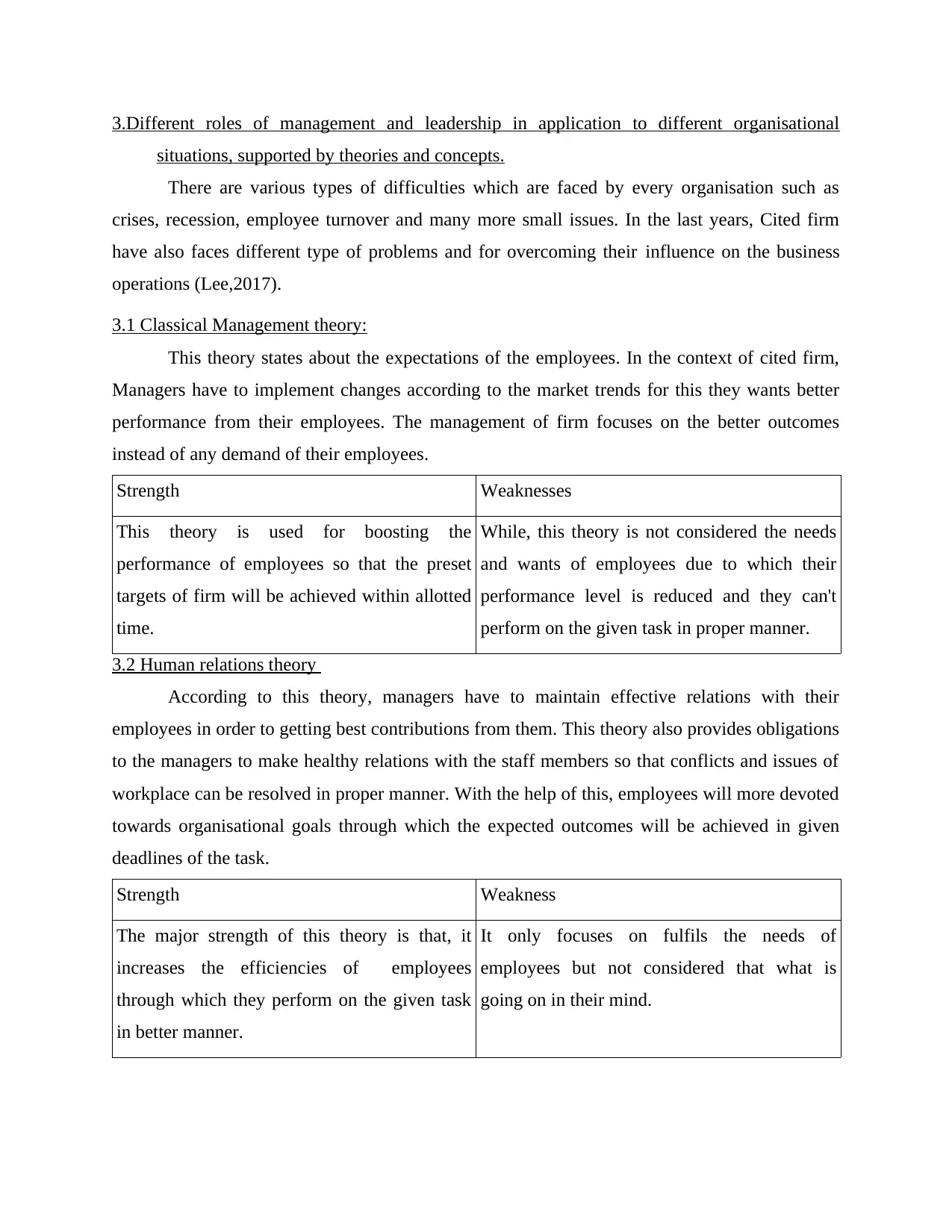
3.Different roles of management and leadership in application to different organisational
situations, supported by theories and concepts.
There are various types of difficulties which are faced by every organisation such as
crises, recession, employee turnover and many more small issues. In the last years, Cited firm
have also faces different type of problems and for overcoming their influence on the business
operations (Lee,2017).
3.1 Classical Management theory:
This theory states about the expectations of the employees. In the context of cited firm,
Managers have to implement changes according to the market trends for this they wants better
performance from their employees. The management of firm focuses on the better outcomes
instead of any demand of their employees.
Strength Weaknesses
This theory is used for boosting the
performance of employees so that the preset
targets of firm will be achieved within allotted
time.
While, this theory is not considered the needs
and wants of employees due to which their
performance level is reduced and they can't
perform on the given task in proper manner.
3.2 Human relations theory
According to this theory, managers have to maintain effective relations with their
employees in order to getting best contributions from them. This theory also provides obligations
to the managers to make healthy relations with the staff members so that conflicts and issues of
workplace can be resolved in proper manner. With the help of this, employees will more devoted
towards organisational goals through which the expected outcomes will be achieved in given
deadlines of the task.
Strength Weakness
The major strength of this theory is that, it
increases the efficiencies of employees
through which they perform on the given task
in better manner.
It only focuses on fulfils the needs of
employees but not considered that what is
going on in their mind.
situations, supported by theories and concepts.
There are various types of difficulties which are faced by every organisation such as
crises, recession, employee turnover and many more small issues. In the last years, Cited firm
have also faces different type of problems and for overcoming their influence on the business
operations (Lee,2017).
3.1 Classical Management theory:
This theory states about the expectations of the employees. In the context of cited firm,
Managers have to implement changes according to the market trends for this they wants better
performance from their employees. The management of firm focuses on the better outcomes
instead of any demand of their employees.
Strength Weaknesses
This theory is used for boosting the
performance of employees so that the preset
targets of firm will be achieved within allotted
time.
While, this theory is not considered the needs
and wants of employees due to which their
performance level is reduced and they can't
perform on the given task in proper manner.
3.2 Human relations theory
According to this theory, managers have to maintain effective relations with their
employees in order to getting best contributions from them. This theory also provides obligations
to the managers to make healthy relations with the staff members so that conflicts and issues of
workplace can be resolved in proper manner. With the help of this, employees will more devoted
towards organisational goals through which the expected outcomes will be achieved in given
deadlines of the task.
Strength Weakness
The major strength of this theory is that, it
increases the efficiencies of employees
through which they perform on the given task
in better manner.
It only focuses on fulfils the needs of
employees but not considered that what is
going on in their mind.
Paraphrase This Document
Need a fresh take? Get an instant paraphrase of this document with our AI Paraphraser

3.3 System Theory – It determines the interrelationship and dependencies on the various
elements of the firm and also helps the managers in dealing with conflicts which are arises in the
workplace.
Strength Weakness
The major strength of this theory is that it lies
in interdependency and exchange of resources
from different departments.
It does not provide the actual picture of
development to the managers
4. Strengths and Weaknesses of different approaches of leadership
There are some effective theories of leadership that can be easily adopted by the leaders
of Toyota. The theories of leadership with strength and weaknesses are briefly explained as
under:
4.1 Situational leadership theory
According to this theory, leaders have to change their behaviour on the basis of
situations. The leaders have to take essential actions which are beneficial for the betterment of
firm. With the help of this, they can improve the efficiency and strengths of their employees. It is
not focuses on the specific qualities of leaders whereas, it emphasizes on enhancing the
flexibility of leaders so that they can make better decisions for the situations (Renz, 2016).
Strength Weakness
It gave freedom to the leaders for making
decisions as per the situations through which
their efficiency can be improved.
The employees can't perform the activities as
expected due to which their productivity will
be lower in some situations.
The major strength of this theory is that, it
improves the maturity of the leaders due to
which they can easily overcome the issues and
enhance the relation with the staff members.
It is applied on the basis of situations so that
leaders can't uses various concepts of
leadership.
4.2 System leadership theory :
According to this theory, leaders have duty to provide an effective structure at the workplace to
their team members. With the help of this, team members can easily understand their roles and
elements of the firm and also helps the managers in dealing with conflicts which are arises in the
workplace.
Strength Weakness
The major strength of this theory is that it lies
in interdependency and exchange of resources
from different departments.
It does not provide the actual picture of
development to the managers
4. Strengths and Weaknesses of different approaches of leadership
There are some effective theories of leadership that can be easily adopted by the leaders
of Toyota. The theories of leadership with strength and weaknesses are briefly explained as
under:
4.1 Situational leadership theory
According to this theory, leaders have to change their behaviour on the basis of
situations. The leaders have to take essential actions which are beneficial for the betterment of
firm. With the help of this, they can improve the efficiency and strengths of their employees. It is
not focuses on the specific qualities of leaders whereas, it emphasizes on enhancing the
flexibility of leaders so that they can make better decisions for the situations (Renz, 2016).
Strength Weakness
It gave freedom to the leaders for making
decisions as per the situations through which
their efficiency can be improved.
The employees can't perform the activities as
expected due to which their productivity will
be lower in some situations.
The major strength of this theory is that, it
improves the maturity of the leaders due to
which they can easily overcome the issues and
enhance the relation with the staff members.
It is applied on the basis of situations so that
leaders can't uses various concepts of
leadership.
4.2 System leadership theory :
According to this theory, leaders have duty to provide an effective structure at the workplace to
their team members. With the help of this, team members can easily understand their roles and

responsibility which will helpful for the firm in achievement of goals. It also helps the leaders of
Toyota to analyse the performance level of their team members through which they can easily
determine the best and lower performer in the firm.
Strength Weakness
It provides the duty to leaders to make a
systematic structure at the workplace through
which the employees aware regarding their
roles and perform well on the given task so that
the desired targets can be achieved.
This theory is not appropriate for every
situations and It fails to provide guidance to
their employees due to lack of systematic
structure.
4.3 Contingency approach of leadership along with strength and weakness
It emphasizes on the modifications in the behaviour of leaders according to the situations
so that they can easily handle the situation. It suggests that best leader has to implement all the
features in their behaviour so that they can make effective decisions according to different
situations. For Example- if sales of the products are decreasing then managers of Toyota have to
consider the quality of product so that the issue regarding sale of product can be easily
overcome.
Strength Weakness
It provides supports in designing an effective
organisational structure so that managers can
easily implement their decisions in the firm.
It not provide effective solutions some time
which enhances the time and cost of firm.
The firm have adopted some kind of theories of leadership and management which can be
used by them in different situations briefly explained as under:
Stable Situation: Under this, the company tried to maintain the quality of their products
for this, the managers have to formulate some effective plans and policies for retaining
the customers for a longer period of time. In this, managers have to play the role of
formulating the plans so that they can easily enhance the quality of the products . On the
other hand, leaders have to take support of contingency approach and provide support and
guidance to their team members so that their effective supports can be gained for
enhancing the quality of products
Toyota to analyse the performance level of their team members through which they can easily
determine the best and lower performer in the firm.
Strength Weakness
It provides the duty to leaders to make a
systematic structure at the workplace through
which the employees aware regarding their
roles and perform well on the given task so that
the desired targets can be achieved.
This theory is not appropriate for every
situations and It fails to provide guidance to
their employees due to lack of systematic
structure.
4.3 Contingency approach of leadership along with strength and weakness
It emphasizes on the modifications in the behaviour of leaders according to the situations
so that they can easily handle the situation. It suggests that best leader has to implement all the
features in their behaviour so that they can make effective decisions according to different
situations. For Example- if sales of the products are decreasing then managers of Toyota have to
consider the quality of product so that the issue regarding sale of product can be easily
overcome.
Strength Weakness
It provides supports in designing an effective
organisational structure so that managers can
easily implement their decisions in the firm.
It not provide effective solutions some time
which enhances the time and cost of firm.
The firm have adopted some kind of theories of leadership and management which can be
used by them in different situations briefly explained as under:
Stable Situation: Under this, the company tried to maintain the quality of their products
for this, the managers have to formulate some effective plans and policies for retaining
the customers for a longer period of time. In this, managers have to play the role of
formulating the plans so that they can easily enhance the quality of the products . On the
other hand, leaders have to take support of contingency approach and provide support and
guidance to their team members so that their effective supports can be gained for
enhancing the quality of products
⊘ This is a preview!⊘
Do you want full access?
Subscribe today to unlock all pages.

Trusted by 1+ million students worldwide
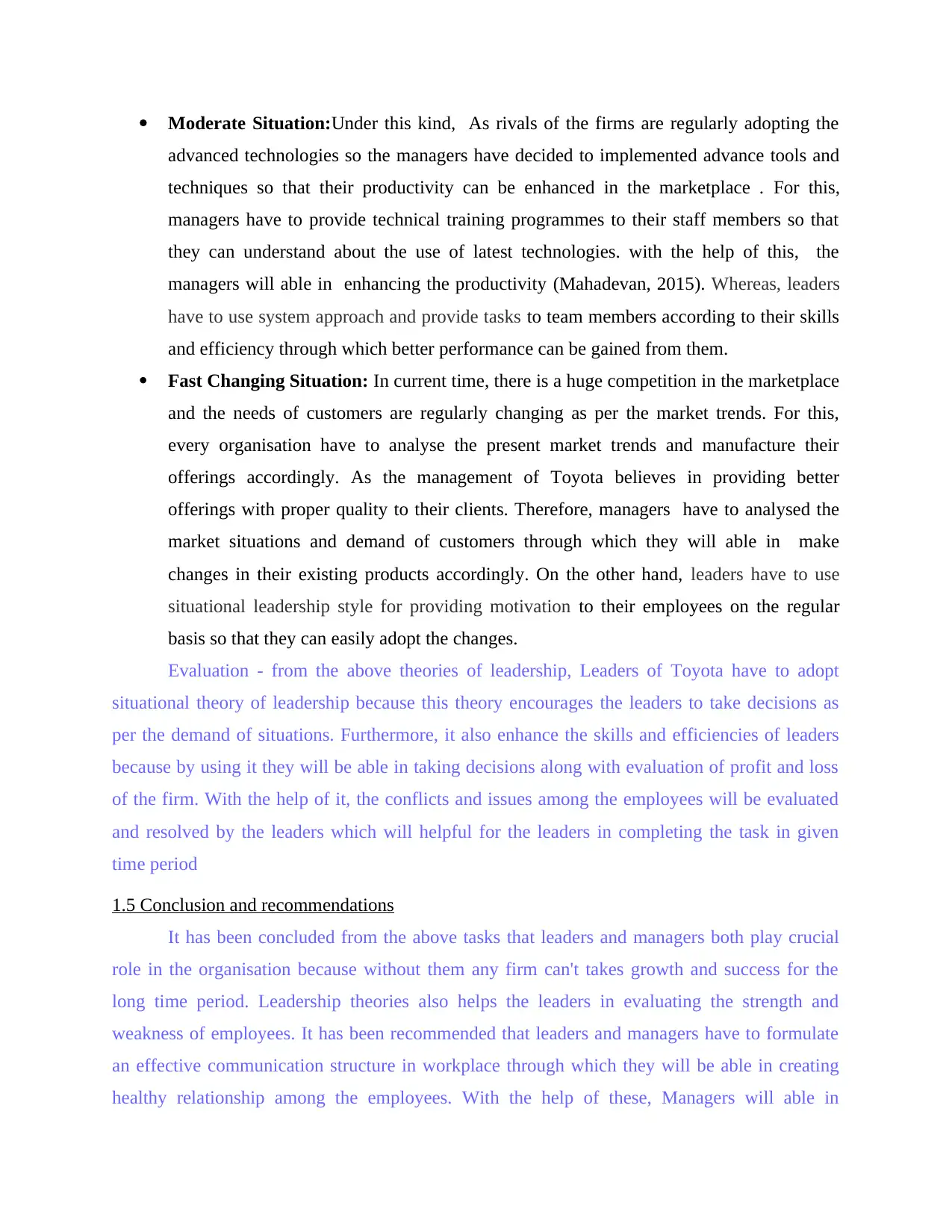
Moderate Situation:Under this kind, As rivals of the firms are regularly adopting the
advanced technologies so the managers have decided to implemented advance tools and
techniques so that their productivity can be enhanced in the marketplace . For this,
managers have to provide technical training programmes to their staff members so that
they can understand about the use of latest technologies. with the help of this, the
managers will able in enhancing the productivity (Mahadevan, 2015). Whereas, leaders
have to use system approach and provide tasks to team members according to their skills
and efficiency through which better performance can be gained from them.
Fast Changing Situation: In current time, there is a huge competition in the marketplace
and the needs of customers are regularly changing as per the market trends. For this,
every organisation have to analyse the present market trends and manufacture their
offerings accordingly. As the management of Toyota believes in providing better
offerings with proper quality to their clients. Therefore, managers have to analysed the
market situations and demand of customers through which they will able in make
changes in their existing products accordingly. On the other hand, leaders have to use
situational leadership style for providing motivation to their employees on the regular
basis so that they can easily adopt the changes.
Evaluation - from the above theories of leadership, Leaders of Toyota have to adopt
situational theory of leadership because this theory encourages the leaders to take decisions as
per the demand of situations. Furthermore, it also enhance the skills and efficiencies of leaders
because by using it they will be able in taking decisions along with evaluation of profit and loss
of the firm. With the help of it, the conflicts and issues among the employees will be evaluated
and resolved by the leaders which will helpful for the leaders in completing the task in given
time period
1.5 Conclusion and recommendations
It has been concluded from the above tasks that leaders and managers both play crucial
role in the organisation because without them any firm can't takes growth and success for the
long time period. Leadership theories also helps the leaders in evaluating the strength and
weakness of employees. It has been recommended that leaders and managers have to formulate
an effective communication structure in workplace through which they will be able in creating
healthy relationship among the employees. With the help of these, Managers will able in
advanced technologies so the managers have decided to implemented advance tools and
techniques so that their productivity can be enhanced in the marketplace . For this,
managers have to provide technical training programmes to their staff members so that
they can understand about the use of latest technologies. with the help of this, the
managers will able in enhancing the productivity (Mahadevan, 2015). Whereas, leaders
have to use system approach and provide tasks to team members according to their skills
and efficiency through which better performance can be gained from them.
Fast Changing Situation: In current time, there is a huge competition in the marketplace
and the needs of customers are regularly changing as per the market trends. For this,
every organisation have to analyse the present market trends and manufacture their
offerings accordingly. As the management of Toyota believes in providing better
offerings with proper quality to their clients. Therefore, managers have to analysed the
market situations and demand of customers through which they will able in make
changes in their existing products accordingly. On the other hand, leaders have to use
situational leadership style for providing motivation to their employees on the regular
basis so that they can easily adopt the changes.
Evaluation - from the above theories of leadership, Leaders of Toyota have to adopt
situational theory of leadership because this theory encourages the leaders to take decisions as
per the demand of situations. Furthermore, it also enhance the skills and efficiencies of leaders
because by using it they will be able in taking decisions along with evaluation of profit and loss
of the firm. With the help of it, the conflicts and issues among the employees will be evaluated
and resolved by the leaders which will helpful for the leaders in completing the task in given
time period
1.5 Conclusion and recommendations
It has been concluded from the above tasks that leaders and managers both play crucial
role in the organisation because without them any firm can't takes growth and success for the
long time period. Leadership theories also helps the leaders in evaluating the strength and
weakness of employees. It has been recommended that leaders and managers have to formulate
an effective communication structure in workplace through which they will be able in creating
healthy relationship among the employees. With the help of these, Managers will able in
Paraphrase This Document
Need a fresh take? Get an instant paraphrase of this document with our AI Paraphraser
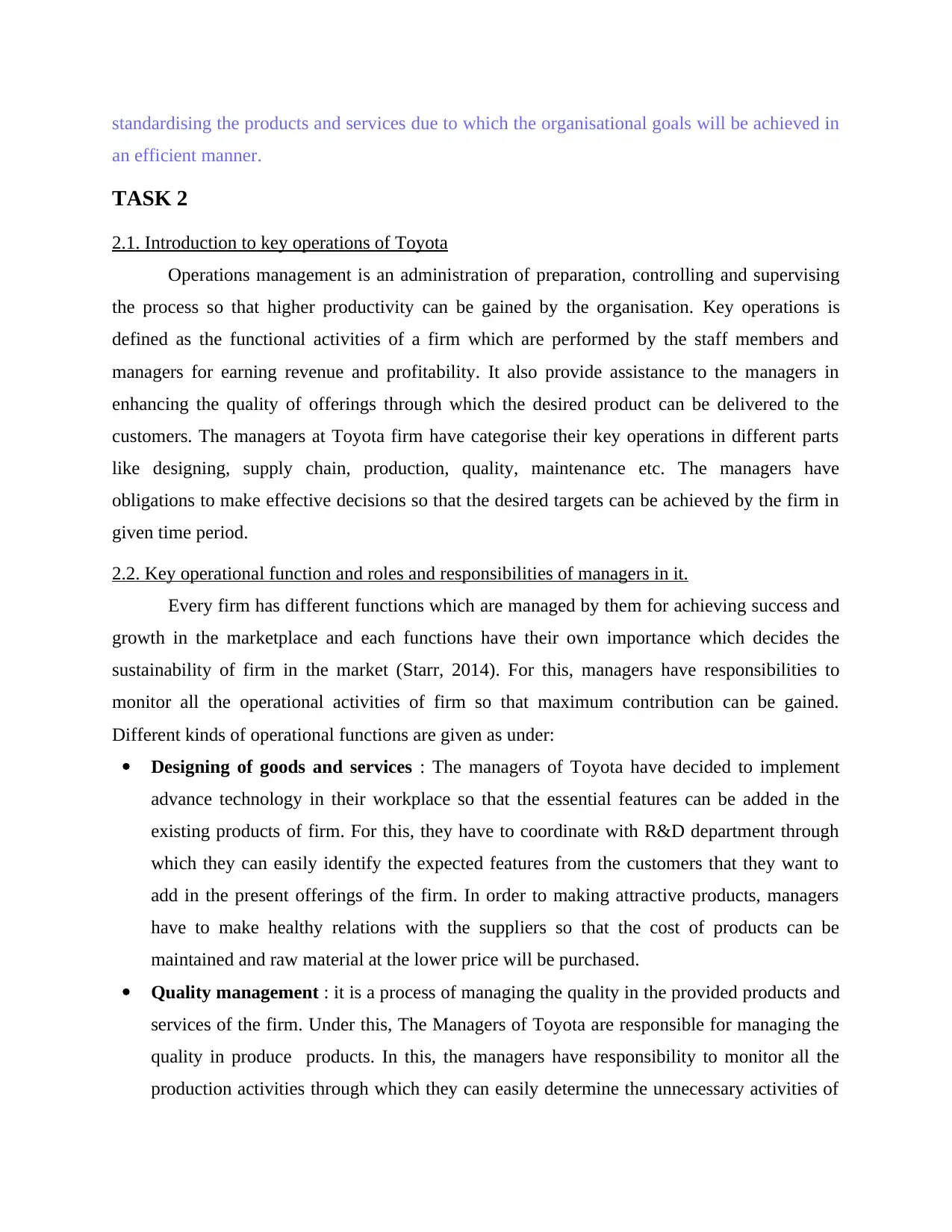
standardising the products and services due to which the organisational goals will be achieved in
an efficient manner.
TASK 2
2.1. Introduction to key operations of Toyota
Operations management is an administration of preparation, controlling and supervising
the process so that higher productivity can be gained by the organisation. Key operations is
defined as the functional activities of a firm which are performed by the staff members and
managers for earning revenue and profitability. It also provide assistance to the managers in
enhancing the quality of offerings through which the desired product can be delivered to the
customers. The managers at Toyota firm have categorise their key operations in different parts
like designing, supply chain, production, quality, maintenance etc. The managers have
obligations to make effective decisions so that the desired targets can be achieved by the firm in
given time period.
2.2. Key operational function and roles and responsibilities of managers in it.
Every firm has different functions which are managed by them for achieving success and
growth in the marketplace and each functions have their own importance which decides the
sustainability of firm in the market (Starr, 2014). For this, managers have responsibilities to
monitor all the operational activities of firm so that maximum contribution can be gained.
Different kinds of operational functions are given as under:
Designing of goods and services : The managers of Toyota have decided to implement
advance technology in their workplace so that the essential features can be added in the
existing products of firm. For this, they have to coordinate with R&D department through
which they can easily identify the expected features from the customers that they want to
add in the present offerings of the firm. In order to making attractive products, managers
have to make healthy relations with the suppliers so that the cost of products can be
maintained and raw material at the lower price will be purchased.
Quality management : it is a process of managing the quality in the provided products and
services of the firm. Under this, The Managers of Toyota are responsible for managing the
quality in produce products. In this, the managers have responsibility to monitor all the
production activities through which they can easily determine the unnecessary activities of
an efficient manner.
TASK 2
2.1. Introduction to key operations of Toyota
Operations management is an administration of preparation, controlling and supervising
the process so that higher productivity can be gained by the organisation. Key operations is
defined as the functional activities of a firm which are performed by the staff members and
managers for earning revenue and profitability. It also provide assistance to the managers in
enhancing the quality of offerings through which the desired product can be delivered to the
customers. The managers at Toyota firm have categorise their key operations in different parts
like designing, supply chain, production, quality, maintenance etc. The managers have
obligations to make effective decisions so that the desired targets can be achieved by the firm in
given time period.
2.2. Key operational function and roles and responsibilities of managers in it.
Every firm has different functions which are managed by them for achieving success and
growth in the marketplace and each functions have their own importance which decides the
sustainability of firm in the market (Starr, 2014). For this, managers have responsibilities to
monitor all the operational activities of firm so that maximum contribution can be gained.
Different kinds of operational functions are given as under:
Designing of goods and services : The managers of Toyota have decided to implement
advance technology in their workplace so that the essential features can be added in the
existing products of firm. For this, they have to coordinate with R&D department through
which they can easily identify the expected features from the customers that they want to
add in the present offerings of the firm. In order to making attractive products, managers
have to make healthy relations with the suppliers so that the cost of products can be
maintained and raw material at the lower price will be purchased.
Quality management : it is a process of managing the quality in the provided products and
services of the firm. Under this, The Managers of Toyota are responsible for managing the
quality in produce products. In this, the managers have responsibility to monitor all the
production activities through which they can easily determine the unnecessary activities of

the production process and remove them accordingly. For making quality products, they
have to make effective relations with the maintenance department so that better quality of
products can be provided to the customers.
Supply chain management : It refers to the supplying of goods and services in the
marketplace. The managers of Toyota has adopted Lean manufacturing system in order to
better supplying the products in the market. Through this system, managers of Toyota will
evaluate the process on the basis of time through which the cost of product will be
maintained and the managers will take more effective decisions for the betterment of firm.
2.3. Key operational approaches of operational management.
There are some essential approaches of operational management which can effectively
applied by the managers of Toyota in order to enhancing their profitability. The approaches are
briefly explained as under:
Total Quality Management: This is an effective approach which focuses on the
improvement in the quality of offerings that are delivered by Toyota. The improvements can be
done in the present offerings on the basis of taken feedbacks from the users. With the help of
this, the firm can easily manufacture the products which will helpful in fulfilling the demands of
customers. The value of this approach is given as below:
Customer Satisfaction:The prior aim of the firm is to make improvements in the products
so that the quality products can be delivered in the market. With the help of this approach,
the satisfaction level of the customer can be enhanced which will be helpful for the firm in
earning profitability (Van Wassenhove, 2014). Process Control: It also helps in monitoring the whole process of the production
department through which the quality of products and services of the firm will be improved
Six Sigma: This process includes various tools which are used for removing the
unessential activities from the production process. It includes various aspects such as
measurement and improvement of the offerings. Value of this approach for Toyota is given as
under:
Saves Time: This process is used for reducing the time of production process through
this approach, the cited firm will be able in manufacturing good products in a short time
period.
have to make effective relations with the maintenance department so that better quality of
products can be provided to the customers.
Supply chain management : It refers to the supplying of goods and services in the
marketplace. The managers of Toyota has adopted Lean manufacturing system in order to
better supplying the products in the market. Through this system, managers of Toyota will
evaluate the process on the basis of time through which the cost of product will be
maintained and the managers will take more effective decisions for the betterment of firm.
2.3. Key operational approaches of operational management.
There are some essential approaches of operational management which can effectively
applied by the managers of Toyota in order to enhancing their profitability. The approaches are
briefly explained as under:
Total Quality Management: This is an effective approach which focuses on the
improvement in the quality of offerings that are delivered by Toyota. The improvements can be
done in the present offerings on the basis of taken feedbacks from the users. With the help of
this, the firm can easily manufacture the products which will helpful in fulfilling the demands of
customers. The value of this approach is given as below:
Customer Satisfaction:The prior aim of the firm is to make improvements in the products
so that the quality products can be delivered in the market. With the help of this approach,
the satisfaction level of the customer can be enhanced which will be helpful for the firm in
earning profitability (Van Wassenhove, 2014). Process Control: It also helps in monitoring the whole process of the production
department through which the quality of products and services of the firm will be improved
Six Sigma: This process includes various tools which are used for removing the
unessential activities from the production process. It includes various aspects such as
measurement and improvement of the offerings. Value of this approach for Toyota is given as
under:
Saves Time: This process is used for reducing the time of production process through
this approach, the cited firm will be able in manufacturing good products in a short time
period.
⊘ This is a preview!⊘
Do you want full access?
Subscribe today to unlock all pages.

Trusted by 1+ million students worldwide
1 out of 19
Related Documents
Your All-in-One AI-Powered Toolkit for Academic Success.
+13062052269
info@desklib.com
Available 24*7 on WhatsApp / Email
![[object Object]](/_next/static/media/star-bottom.7253800d.svg)
Unlock your academic potential
Copyright © 2020–2025 A2Z Services. All Rights Reserved. Developed and managed by ZUCOL.





